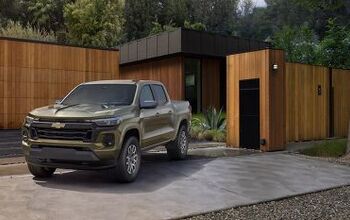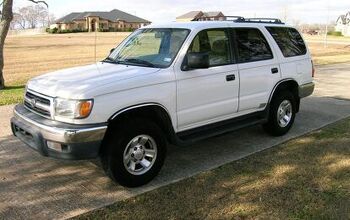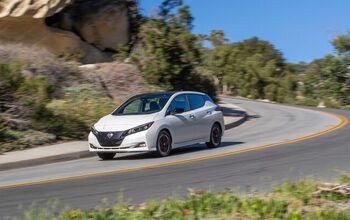A Visit To Ford's Wind Tunnel To Look At The New Mustang's Slick Aero Tricks

Click on the settings icon in the menu bar of the video above to watch it in 2D or your choice of 3D formats.
The second best part about the job of writing about cars is not getting to drive expensive cars for free or being flown to resorts with Jacuzzi tubs. No, the second best part about the gig is that I get to see and do some very cool car guy things. How many of you have watched film or video of a car being tested in a wind tunnel and thought to yourself, “that’s neat!”? Well, this week I got to observe the new 2015 Ford Mustang’s aerodynamic features demonstrated in one of those neat wind tunnels.
As part of the publicity campaign leading up to the April introduction of the all-new 2015 Ford Mustang, Ford is going to have a series of presentations to Detroit area automotive media types and they kicked it off with a visit to FoMoCo’s Driveability Testing Facility in Allen Park. The DTF contains a number of test cells that allow Ford engineers to duplicate just about any temperature, altitude or meteorological condition (including snow and hail) a driver might experience. Three of the test cells are wind tunnels large enough to test full size cars and Ford’s marketing and engineering folks had a preproduction black 2015 Mustang GT coupe sitting in one of them.
After Kemal Curić, who was in charge of exterior design on the new Mustang, did a walkaround, pointing out the various aerodynamic features of the car, they fired up the fans to 30 mph and a technician used a smoke wand so we could actually see just how effective those features are.
When the 2015 Mustang finally hits the showrooms later this year, you may not notice the differences, but each of the models has been fine tuned for aerodynamic balance. Ford says that they spent twice as much time on the new Mustang’s aerodynamic performance as on the outgoing model. Much of that work was done in the digital domain, which can work at a very fine granular resolution that can’t be replicated with real-world pressure sensors or physical tufts, but still everything is subjected to real-world testing with real airflow in a wind tunnel.
Some of the changes are almost imperceptible, for example, raising or shaving the surface of the rear deck lid by as little as 1 millimeter will have an observable and significant effect. Each model, Ecoboost 4, V6 or GT, has slightly different aero features and if you order the performance package on the GT, that gets its own special wind-cheating tricks. For example, EcoBoost powered Mustangs will feature active grille shutters that close to reduce drag at higher speeds. Different front splitters and functional rear underbody air extractors were developed for each model. The front fascia on all models incorporates ducts that create aero wheel curtains that isolate the spinning wheels and tires from turbulence, a first for Ford.
Wheel aero curtains on the 2015 Mustang
Most of the work is aimed at reducing turbulence and hence drag by keeping the airflow closely attached to the car body’s surface as it passes the car. With the smoke wand set right at the leading edge of the hood, the trail smoothly runs from the nose of the car up over the roof and then down the fastback roofline and over the integrated spoiler on the deck lid. It’s only when the smoke is finally trailing the car that you see any turbulence, though as it transitions past the functional cold air intake for the engine at the base of the windshield you can see the eddies curling air down into the induction system.
Another of the aero features of the front end are functional air extractors in the hood. Not only do they prevent air pressure from building up under the hood, Curić said that they actually create downforce. Moving back along the car, the side mirrors have been moved from the window frame down to a stalk on the door. That aerodynamically isolates the mirror from the body, allowing laminar flow along the window. The mirror itself has been shaped so that air flows smoothly around and past it. A side skirt below the rocker panel works with the front splitter to keep underbody airflow separate from the upper air. One aero device you might not notice is a small flap spoiler mounted under the car just in front of each rear wheel, intended to smooth the flow of air around the rear tires.
The rear decklid of the new Mustang GT is the collaborative product of the designers, aerodynamicists and the manufacturing engineers. You may not realize this when you see the complex shapes on modern cars, but there’s a constant struggle between the designers and the body engineers over what is possible, or more importantly, what is possible at a price point. The decklid on the 2015 Mustang is a relatively complicated shape, particularly because they decided on an integrated spoiler, not a bolt on part. It’s one thing to get a clay model to perform well in the wind tunnel, it’s another thing to be able to reproduce that shape in metal or plastic production parts.
One reason why they don’t just rely on testing aero with fluid dynamics in the digital domain is that the wind tunnel isn’t just used for aerodynamics. Microphone arrays mounted above and to the side of the car are used to measure noise and are part of the process of reducing NVH. Interior sound measurements are taken with the audio equivalent of crash test dummies, but I was told that exterior measurements correlate well with how much noise there is inside the car, which makes sense.
At the event I learned a little bit about how they do wind tunnel testing at Ford and how that affects the way the new Mustang looks and drives. I also learned a bit about just how serious the Ford engineers and designers are about wringing out a small percentage improvement here and another one there. When it comes to aero, all those little things add up. Though they wouldn’t cite a specific drag coefficient, we were told that the new Mustang is 3% better in terms of aerodynamics than the 2014 model, yielding a 1% improvement in highway fuel economy. As you can see from the acoustic testing, though, it’s not only about miles per gallon.
Almost one in five Mustangs that are sold currently are convertibles. Before the wind tunnel presentation we heard about the Webasto supplied folding roof on the new Mustang convertible and how it’s quieter, goes up and down faster (an electromechanical drive replaces hydraulics), folds flatter, looks better both up and down, and, yes, has better aerodynamics than the ragtop on the outgoing model. The old roof had three supporting bows, a vinyl outer skin and an inexpensive inner skin. The new roof has an additional bow to give the roof better shape, the outside is fabric, the inside is real headlining material and between them, for the first time on a Mustang, is a layer of sound and heat insulating foam. One of the reporters asked them if the improvements were made in response to consumer feedback. The Ford engineer replied that yes, they had gotten feedback indicating that Mustang owners wanted a quieter car, and then, almost as an aside, he said, they wanted to give the new Mustang a better roof in general.
It’s quite difficult to convey to people just how massive an undertaking it is to develop a new car. I’m sure that what I saw at Ford is duplicated at every major car company. Because of this job I get a peak behind the curtain now and then and I get to pay attention to the men and women working behind that curtain. However, instead of charlatans pulling levers projecting the image of greatness, there are lots of very hardworking people making great efforts at incremental improvements that, taken cumulatively, positively impact our experiences as drivers and car owners.
Ronnie Schreiber edits Cars In Depth, a realistic perspective on cars & car culture and the original 3D car site. If you found this post worthwhile, you can get a parallax view at Cars In Depth. If the 3D thing freaks you out, don’t worry, all the photo and video players in use at the site have mono options. Thanks for reading – RJS

Ronnie Schreiber edits Cars In Depth, the original 3D car site.
More by Ronnie Schreiber
Latest Car Reviews
Read moreLatest Product Reviews
Read moreRecent Comments
- Offbeat Oddity The RAV4, and I say this as someone who currently owns a 2014 CR-V. My aunt has a 2018 CR-V that has had a lot of electrical issues, and I don't trust the turbo and CVT to last as long as Toyota's NA engine and 8-speed automatic. Plus, the RAV4 looks sportier and doesn't have the huge front overhang.
- Offbeat Oddity I'd go with Mazda, especially now that there's no more cylinder deactivation on the 2024 NA motor. It's around $4-5k less than the Toyota with similar equipment, and I think reliability is probably very close between them.Regarding reliability, hasn't this generation of RAV4 taken a hit? I know it's not rated as highly in Consumer Reports, and there were teething issues during the first few years. I'm surprised it's not mentioned in more reviews- even Jack Baruth's. I'm sure the bugs have been worked out by now, though.
- Peter I want a self driving red ragtop 1958 Plymouth Fury. Just like the car in the movie Christine.
- Mgh57 Doesn't seem like this tech is ready for prime time.
- Nathan The Ram is the most boring looking of the full size trucks, kind of like a Tundra.If they cancel the Ram Classic, I hope a full resign makes the Ram at least look interesting.







































Comments
Join the conversation
Hopefully with all their fancy air blowing rooms Ford will done day figure out how to merge aerodynamics AND decent styling.
I very much appreciate it when the OEM's spend the time and money to get the airflow right around the wheels. You can always tell who didn't bother on a misty highway drive. It's great fun to actually watch airflow in traffic. For some reason my beloved Mopar can't seem to get it together regarding under-body and wheel area airflow.